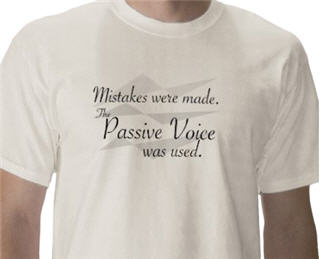How to Teach Passive Voice



Teaching active vs passive voice is an important lesson. But it’s one that requires a good deal of prerequisites.
Before diving into active vs passive voice, I suggest making sure you’ve covered sentence structure, subjects, nouns, verbs, and prepositions. Without this foundation, your students will likely have a hard time understanding how to correct passive voice errors.
Additionally, subject-verb agreement lessons, the difference between a subject and an object, and a solid understanding of verb tense will help immensely, so I suggest teaching those lessons prior to tackling voice as well.
Of course, we have tons of resources dedicated to verb tense:
And, on a final note, this article focuses on resources for teaching your lesson. If you were hoping for a step-by-step guide to teaching passive voice, we have that too, but you’ll want to visit this article again after checking out the other one.
With that out of the way, we broke this article down by resource type so you can easily identify whatever resources will be most helpful for your class.
Of course, the nuts and bolts of the whole thing are easy enough for you to understand. But to help your students grasp the concept, we suggest starting with this simple active vs passive voice worksheet. It covers the basic formula of both active and passive voice in an easily digestible way and includes examples in various verb tenses.
This PowerPoint presentation includes a walkthrough for presenting it, when to show what, and a whole list of additional resources for teaching with it. Expect it to take you roughly two hours to complete with your class, but by the end of it, they should have passive voice down pat.
Although it was intended to be used for teaching EFL students, with a few additional prerequisites and a couple of modifications, it should work just as well for advanced ESL students.
This Lesson plan covers both active and passive voice and explains how they differ in form and meaning. Additionally, it shows how to turn passive voice into active voice, a few exercises for your students to complete, and a summary of the lesson.
Though this isn’t a standalone lesson plan, it is certainly a great foundation for your students.
This short worksheet is designed to help students change passive voice to active and active voice to passive. The worksheet includes 19 of both types. It was created for 7th-grade students who speak US English, but it’s easy to edit the worksheet to fit the needs of your class.
This worksheet is written in UK English for students to practice passive voice with various verb tenses. It lists out things that were done last week at “Tom’s house” that your students will have to create sentences to describe.
IE: The windows were cleaned and the carpet was washed.
But the worksheet goes on to cover passive voice in the present verb tense as well.
This active to passive voice worksheet includes three sections to keep your students a little more engaged in the lesson. The first section covers converting active voice to passive. The second section covers choosing the correct verb voice based on several provided answers. And the third section is a write-in section where students need to write in the correct verb voice in the correct tense based on the sentence.
This worksheet is broken up into six sections. The first section is identifying active vs passive voice for each sentence. The second and third parts are the sentence rewrite portion. Moving onto the fourth portion, your students need to differentiate object from subject and break down each part of the given sentences. The fifth part includes correctly choosing which verb form to use.
And, finally, the worksheet ends with your students writing a story about one of the four provided prompts. The criteria they need to follow includes using at least 10 verbs, with three of them being in passive voice.
This passive voice test draws inspiration from Jeopardy. The teacher asks the question to the student, but in order to answer correctly, the student must provide their answer in passive voice. If you feel like your students won’t be interested in an oral test, you can always modify the game by giving each student a paper to write their individual answers on.
This printout includes both questions and the answers, but it’s in a Word document so you can easily modify the questions and answers as some of the questions are likely for a much older age group. IE: “Who directed Pulp Fiction?” “Quenton Tarantino directed Pulp Fiction.”
Although you could also keep the questions and grade based on the verb voice versus the actual answer.
This exercise works similar to a relay race where one student runs to the board and brings the answer back to the other student to write, then the other student runs to the board and brings the answer back, and so on until they have all the answers written down.
The catch here is that the sentence on the board is in active voice, whereas the answers need to be written in passive voice.
If you’re interested in more activities like this, but this one isn’t quite a fit for your class, we have an entire article dedicated to teaching passive voice while being active.
This activity uses cartoons on YouTube, though you don’t have to watch the videos to be able to convert the sentences. The idea is for your students to convert active voice to passive voice based on the start of the sentence. For example:
The cat was chasing the mouse.
The mouse ___________ (was chased by the cat.)
This particular worksheet works well for students who may need a little bit of a hand on how to construct converting sentences from active to passive.